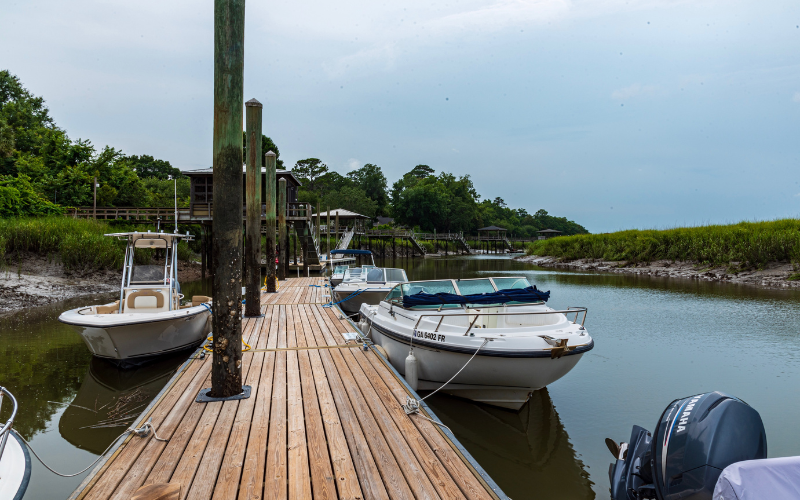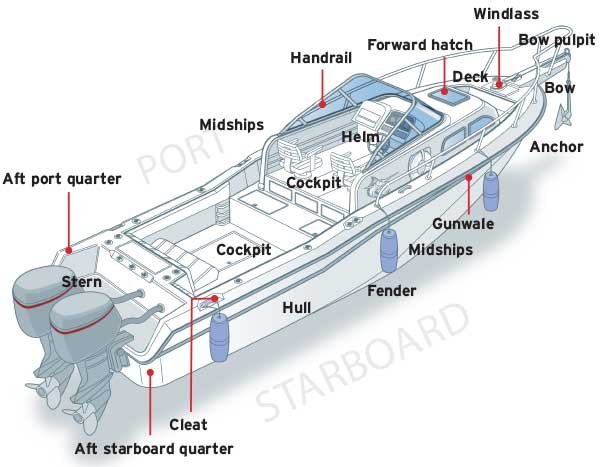Salty Marine Terminology for Beginners
Marine Terminology is a can of worms.
For example, a “ceiling” is the liner on the “sides” of the hull. What you think would be the “ceiling” of a cabin is called the “overhead.” Confusing, isn’t it?
What difference does it really make if you call the pointy end of a boat the “bow” or the “front?”
What difference does it make if you say “I am turning to port” or “I am turning left?”
I’ve observed that people with the most boating experience use the fewest marine terms. Just like you’ll seldom find an experienced yachtsman wearing one of those cheap captain’s hats you buy in the marine store, complete with scrambled eggs on the visor and “Captain” emblazoned in rhinestones, you’ll not likely find an experienced individual throwing marine jargon about it.

In any field, it’s the insecure neophytes who learn the terminology and use it to show their compatriots that they are knowledgeable. The guys already in the field don’t worry about this and usually call things what they damn well please, knowing that it’s results that count. After you’ve rammed the dock, it doesn’t really matter if you say, “Gee, I stove in the stem on the bollard” or “Gee, I crashed the front end on that dock thing” does it?
Using marine terminology can even be dangerous since it is fraught with double meanings. Did you ever think how a landlubber might interpret your nautical jargon? Here is a list of marine terms as they might be defined by a landlubber.
- Carvel Planking: The skin of a hull made up of soft ice cream.
- Dinghy: A dark, dirty place.
- Ballast: One who participates in ballet dancing.
- Camber: A type of French cheese.
- Halyard: A grassy area around a house owned by Hal.
- Strut: A peculiar way of walking employed by women to attract men.
- Rudder: A name for people having ruddy complexions.
- Fairbody: A physique that is not particularly exceptional, but is not poor either.
- Prop: What you use your arm for to support your chin at the bar.
- Port: What you drink at the bar.
- Starboard: A listless movie actor.
- Bow: What you do after performing an outstanding docking maneuver.
- Stern: The way you feel after bashing a piling.
- Folkboat: Boat anchored off the three-mile limit for the purpose of prostitution (think about it).
- Scupper: The meal after lunch.
- Slip: The next-to-last article of clothing you remove from a woman’s body.
- Berth: Sometimes the result of removing the last article of clothing.
- Freeboard: A cruise on a vessel that you don’t pay for.
- Chainplate: A method of securing dinnerware to the table when at sea.
- Stemhead: The guy with a long neck and a small head.
- Kelp: What you yell for when you’re in trouble.
- Dockline: Direct telephone access to a physician.
- Flying Bridge: A type of card game played on an aircraft.
- Seacock: A nautical rooster.
- Bulkhead: A person with a very large cranium.
- Fuel Tanks: Giving thanks for having fuel available.
- Berth Board: A condition that afflicts women who’ve had too many children.
- Windward: A section of a hospital for people with chronic gas problems.
- Windlass: A condition resulting from successful treatment in a windward.
- Chine: What the sun does.
- Oar: A woman of ill repute.
- Oar Lock: A security device that women of ill repute have on their doors.
- Cabin Sole: A pet fish kept in the cabin.
- Thwart: A bump on the skin thought by some to be caused by toads.
- Skeg: What beer comes in.
- Ketch: A game of ball.
- Sloop: One who dribbles fool when he eats.
- Metacenter: A place where singles gather to meet other singles.
- Polyester: Frank Ester’s sister.
- Rudder Stock: Shares in a rubber company.
- Scantling: The newborn of a scant.
Oh yes, with the above definitions in mind, think twice the next time you’re at a fancy restaurant or your church social telling sea stories. Think how this will sound to a blue-haired grandmother type: “I went out on the folkboat, inspected her fairbody, then checked her strut. Since I didn’t want anyone else to use them, I put the oars in my cabin.”
(Reprinted with permission of Regina Fexas.)
If you would like to read more of Tom's pearls of wisdom, tune in next Friday — "Fexas Friday."
Better yet, why not get a full dose of infectious Fexas whenever you need it — and buy one of the volumes below. Better yet, why not buy all of them — we call them the "Fexas Five." They will provide many evenings of fun reading (better than Netflix) and you'll make Regina very happy knowing that Tom will live on with you the way most of us remember him.
Order 1, 2 or "The Fexas Five" —
To find the "Fexas Five" on Amazon, click here...
Tom Fexas (1941-2006) was one of the most influential yacht designers of the last quarter of the 20th century. With the narrow Wall Street commuters that were built in the 1920s and '30s always on the back of his mind, he wanted to design boats that were at once fast, comfortable, seaworthy and economical to operate. Over the years, he and his firm designed over 1,000 yachts for some of the most prestigious boat builders in the world, including Cheoy Lee, Palmer Johnson, Grand Banks, Mikelson Yachts, Burger, Abeking & Rasmussen and many others.
Even though toward the end of his career he only designed megayachts and superyachts, including the remarkably influential PJ "Time" in 1987, he is best remembered for his first major vessel in 1978 — Midnight Lace — which became a series of 44-52-footers. They were light, narrow, and fast with relatively small engines. He was also influential in the boating community because of the monthly column he wrote for Power and Motoryacht, which began in its very first issue in January 1985.

